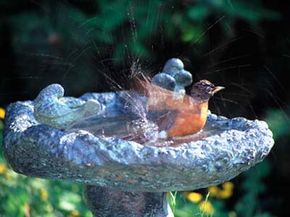Lawn & Garden

To create a backyard wildlife habitat, it is important to have a source of water like a small pond. This will attract animals to your backyard.
Michael Cogliantry/Riser/Getty Images
Some people prefer to stay close to home when they want to experience nature’s beauty. They create backyard wildlife habitats to bring nature to them. These habitats provide a haven for animals and can also be enjoyed by birdwatchers, butterfly lovers, and gardening enthusiasts. To be recognized as a certified backyard wildlife habitat, there are specific requirements that must be met. In this article, we will discuss these requirements.
Designated backyard wildlife habitats, also known as certified wildlife habitats and backyard wildlife sanctuaries, serve several purposes. They allow people to enjoy nature from the comfort of their own homes and can increase a home’s privacy and value. Additionally, these habitats help combat habitat loss and ecological degradation. By caring for a wildlife-friendly garden, you improve the environment by composting and reducing the use of chemical pesticides. Animals also play a role in taking care of the environment by pollinating plants, dispersing seeds, and eliminating pests.
In the next section, we will discuss the essential components of a backyard wildlife habitat and why each one is crucial for certification.
The Essential Elements of a Backyard Wildlife Habitat

Creating a birdbath may seem like a lot of work, but seeing a robin splashing around in it makes it all worth it.
Steve Satushek/Photographer’s Choice/Getty Images
There are four basic components that must be present for a backyard to become a successful wildlife sanctuary. These include food, water, shelter, and space. If you plan on creating a backyard wildlife habitat, you must carefully consider how to incorporate these elements in a way that is enjoyable for both you and the animals that will inhabit the space.
Creating a backyard wildlife habitat is a great way to invite animals to your garden, but it requires some planning and maintenance. Experts suggest planting native plants that can withstand the climate and provide food for the animals. A mix of plants that produce nectar, nuts, berries, seeds, fruits, and other snacks throughout the year is ideal. You can also add feeders, especially in the cold season. Water is another essential element for animal survival, and it should be clean and accessible. You can create ponds, birdbaths, or butterfly puddling areas. Shelter is also crucial, and a backyard wildlife habitat should resemble a natural landscape with layers of ground cover, tall flowers, shrubbery, and trees. Natural havens like rock piles, brush heaps, and hollowed out logs are also great. To keep everyone happy, provide enough supplies, including duplicated resources and a variety of offerings. Observing how the habitat functions can help you develop it further. Remember to nestle food into shelter and keep water close to protective cover.
If you want to attract wildlife to your backyard, you need to plan carefully. Before you head to the nursery, create a design and do your research to avoid wasting time and money on plants that won’t attract the animals you want. Choose a diverse selection of hardy native plants that can provide food and shelter year-round. Consider how native fauna interact with local flora, and include plants that provide nesting material and places to lay eggs. Sustainable gardening is important, so reduce grassy areas, compost and mulch, choose drought-resistant and native plants, and minimize chemical use. To get your backyard certified by the National Wildlife Federation, make sure it provides a suitable environment for species survival, and fill out a checklist detailing your backyard features, including natural food sources, supplemental feeders, water, shelter, and nesting provisions. You can even register your yard with state agencies and order a sign to acknowledge your finished habitat.
After obtaining certification, it is possible that you may not immediately see wildlife in your yard. This could be due to a delay in word spreading that your yard is open for business or because you missed a crucial step. Some of the common mistakes include using inorganic mulch that does not attract bugs, having birdbaths in exposed areas, lacking handy hiding places for birds to make clandestine arrivals and quick getaways, and not having enough sunny patches and nectar-rich flowers for butterflies. Even something as simple as a pile of sticks or yard waste could be the perfect home for a mammal on the move. Making small adjustments to your gardening techniques could help attract more fauna.
If you’re looking to step up and do your part for the environment, the next page includes useful links with information on frogs in danger, farms in skyscrapers, and more. Extension agents, nursery workers, master gardeners, and other nature enthusiasts can provide valuable advice for those just starting the National Wildlife Federation certification process. They can offer soil quality testing and tips on appropriate plant species and animal habitat preferences.
There are also plenty of related HowStuffWorks articles and great links to organizations such as the National Resources Conservation Service, the National Wildlife Federation, the Nature Conservancy, and the United States Botanic Garden. Sources such as the Backyard Wildlife Habitat website, Bronx Green-Up, and the University of Maine Cooperative Extension provide further information and tips on creating a wildlife-friendly yard.
FAQ
1. What is a backyard wildlife habitat?
A backyard wildlife habitat is a space in your yard that is designed to provide food, water, shelter, and nesting sites for various species of wildlife. It is a way to create a natural environment in your own backyard and support the local ecosystem.
2. Why should I create a backyard wildlife habitat?
Creating a backyard wildlife habitat is a great way to help the environment and support local wildlife. By providing food, water, and shelter, you can attract a variety of species to your yard and help to create a sustainable ecosystem. It is also a fun and educational project for families and a great way to connect with nature.
3. What are some basic elements of a backyard wildlife habitat?
The basic elements of a backyard wildlife habitat include food sources such as plants and bird feeders, water sources such as bird baths and ponds, shelter such as trees, shrubs, and nesting boxes, and nesting sites such as brush piles and hollow trees.
4. What types of plants should I include in my backyard wildlife habitat?
Include a variety of native plants that provide food and shelter for wildlife. Examples include wildflowers, shrubs, trees, and grasses. Choose plants that bloom at different times of the year to provide a continuous food source for pollinators and other wildlife.
5. How can I provide water for wildlife in my backyard?
You can provide water for wildlife by installing a bird bath, a small pond, or a water feature. Ensure that the water is clean and changed regularly to prevent the spread of disease.
6. How can I create shelter for wildlife in my backyard?
You can create shelter for wildlife by planting trees, shrubs, and other plants that provide cover and nesting sites. You can also create brush piles using fallen branches and leaves.
7. How can I attract birds to my backyard wildlife habitat?
You can attract birds to your backyard wildlife habitat by providing a variety of food sources such as bird feeders and native plants that produce seeds and berries. You can also provide nesting sites such as birdhouses and nesting boxes.
8. How can I attract butterflies to my backyard wildlife habitat?
You can attract butterflies to your backyard wildlife habitat by planting native plants that provide nectar and host plants for butterfly larvae to feed on. Examples include milkweed, butterfly bush, and coneflowers.
9. How can I attract bees to my backyard wildlife habitat?
You can attract bees to your backyard wildlife habitat by planting native plants that provide nectar and pollen. Examples include wildflowers, sunflowers, and lavender. Ensure that your garden is free of pesticides and other chemicals that can harm bees.
10. How can I create a safe environment for wildlife in my backyard?
You can create a safe environment for wildlife in your backyard by avoiding the use of pesticides and other chemicals, providing shelter and nesting sites, and installing bird feeders and water sources that are clean and changed regularly.
11. How can I maintain my backyard wildlife habitat?
You can maintain your backyard wildlife habitat by regularly cleaning bird feeders and water sources, removing invasive plant species, and pruning trees and shrubs to ensure they are healthy and provide adequate cover and nesting sites.
12. Are there any resources available to help me create a backyard wildlife habitat?
Yes, there are many resources available to help you create a backyard wildlife habitat. Your local extension office or conservation department can provide information on native plants and wildlife in your area. The National Wildlife Federation also offers a certification program for backyard wildlife habitats.

Brody is a skilled craftsman and gardening expert. From renovating living spaces to cultivating lush gardens, Brody’s knowledge and passion shine through, inspiring readers to embark on their own home improvement and gardening journeys with confidence.






Leave a Reply